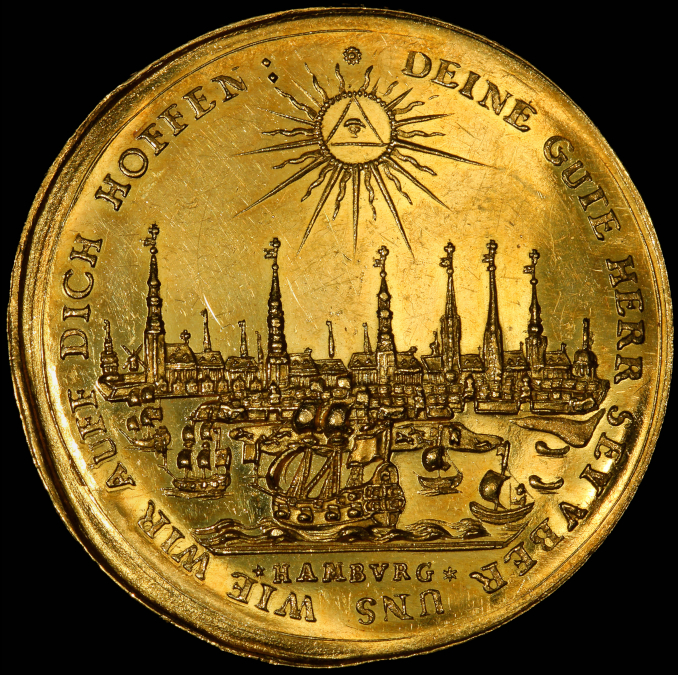
Photo: Wikimedia Commons
By Nina Heyn – Your Culture Scout
Even though practically every major ruler in world history has issued some coinage, just a handful of currencies have gone on to become international standards—used for a long time and widely traded. These include the drachmas of ancient Greece, the Roman Empire’s denari, and a coin called the solidus in the Byzantine empire. Out of the Italian peninsula came Venetian ducats and Florentine florins, currencies that functioned as international standards for centuries. By the 17th century—and thanks to the Dutch East India Company’s success—the guilder (aka gulden) became a dominant reserve currency, to be followed later by the British pound and then the American dollar. While these currencies, at some point, became names for specific trading values, detached from the original coins, the actual coins also became convenient ways of paying for small purchases or amassing as collectibles.
Despite their utilitarian purpose, from the earliest days, coins would often also be works of art. In fact, the older the coins, the more they were artistically varied. Animals were popular on coins of antiquity, which featured all manner of creatures—turtles, lions, eagles, dragons, elephants, snakes, dolphins, octopi, bulls, owls, and even an occasional pegasus—albeit with different symbolism than we have today. For example, Caesar’s silver denarius coin, widely minted to pay the Roman legions, features an elephant and a snake. Some historians have posited that because the elephant was associated with Caesar’s long-time rival (general Pompey the Great), it would have had a negative connotation, while the snake, considered a natural enemy of the elephant, would have symbolized curbing the elephant’s power.
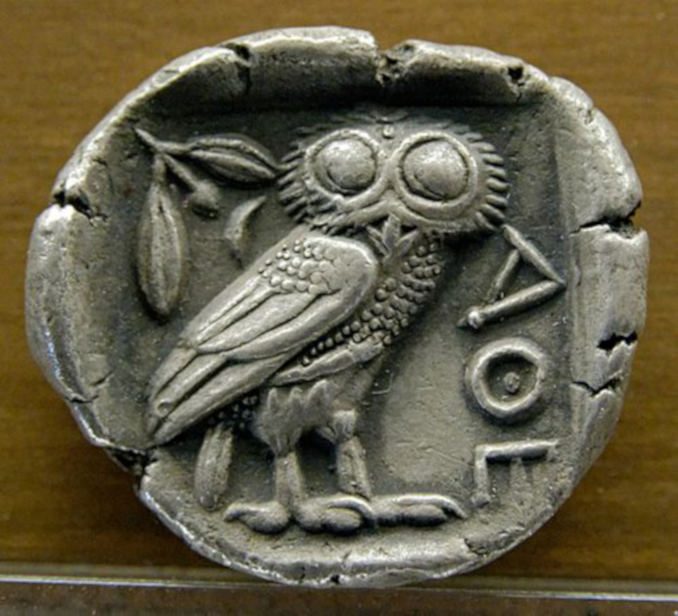
Photo: Wikimedia Commons
The owl was an attribute of the goddess of Athena and, hence, a symbol of wisdom, erudition, and knowledge. It was widely used by the city-state of Athens to signify its coins’ origin and, therefore, the image started to appear on tetradrachm coins from about 510 BC. The tetradrachm above was issued after the Greeks finally defeated their archenemy, Persia, in 479 BC. This particular silver coin is displayed in a French art museum. It is indeed a charming work of art, with the owl’s dainty turn of the head, huge eyes, and finely detailed feathers. Other drachma owls tend to be less graceful. The obverse of this coin is a head of Athena.
Various versions of the ancient drachma were in circulation for about 1000 years. The Greek word for drachma was derived from the word for “grasp,” and initially the payment token was literally a bunch of six sticks that you could grasp. Eventually this evolved into a coin; a “drachma” (or its multiplier or a fraction) became standard coinage throughout ancient Greece from about 1100 BC onwards.
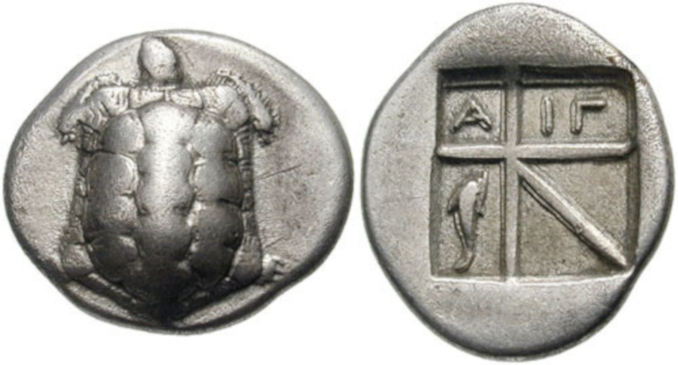
One of Aesop’s fables talks about a nymph from Arcadia called Chelone (“tortoise” in Greek) who refused Zeus’s invitation to a party, preferring to stay at home instead. She soon found out that turning down invitations from gods is perilous, after he sent Hermes to turn her into a sea turtle who always carries her house on her back. The drachma of Aegina island features this mythological tortoise, here in a wonderful relief that makes this piece of silver more of a sculpture than a coin. The reverse bears the name of the island and a dolphin. The earliest Chelone coins are from about 700 BC.
From the time of Julius Caesar, if a ruler managed to stay in power long enough to get new coins designed and minted, his image would soon find its way onto a coin. This is a tradition that continues to this day on numerous coins (especially in countries that still have monarchies). From the point of view of art, imperial heads are less interesting, but there is an interesting exception in the form of this gold solidus bearing a portrait of Empress Irene, an early East Roman empire ruler.

Photo: phgcom via Wikimedia Commons
Irene of Athens was married off in 768 AD to the Byzantine emperor Leo IV. When the emperor died 12 years later, her prospects of survival were not very good. The typical fate of an imperial widow would have been exile, if not outright execution. Instead, Irene managed to become a regent on behalf of her son Constantine VI. She tried to maintain power and peace by improving strained relationships with the pope in Rome and by paying tributes to powerful caliphs of the Abassid kingdom. However, when her son reached adulthood, the power struggle between mother and son erupted in full force.
The coin above comes from the period of Irene’s co-regency. She is portrayed as more important than her son since she is holding an imperial orb. After the prince-regent’s attempt to conspire against her, she retaliated by having him captured and his eyes gouged, which led to his demise a few days later. Irene became a sole ruler, which is reflected in the solidus coin minted at the end of the 8th century—she is there all alone, holding the attributes of power of a crown with pearl strings, an orb, and a scepter. She is named here as basilissa (empress) rather than as emperor—a sure sign of her power. She was one of three women to wield sole power in the entire history of the Byzantine empire of more than 1000 years.
Irene’s political rise was not acceptable to other monarchical players, however. On Christmas Day of the year 800, pope Leo III crowned Charlemagne the Holy Roman Emperor, thus creating several hundred years of schism that only ended with Constantinople’s fall to the Ottomans in 1453. Irene’s spectacularly bad motherhood was not enough to keep her in power. Five years after her son’s demise, patricians from her entourage mounted a successful conspiracy, replaced her with a man who had previously been a minister of finance, and exiled her to the island of Lesbos to spin wool. Irene died a year later—wool spinning being apparently more dangerous than ruling the entire empire.

Ancient Romans used the denarius, an almost pure silver coin introduced in 211 BC that steadily lost its silver content and value for several hundred years. Roman legionnaires during Julius Caesar’s time were paid an annual salary of 225 denarii. The biblical “tribute penny,” a coin held up by Jesus in the passage about “rendering unto Caesar,” is believed to have been a denarius minted during the reign of emperor Tyberius. The coin above, from the period of Marcus Sergius Silus—a general celebrated for his bravery during the second Punic War—features two significant images. The head is a stylized Roma as a goddess—the symbol of the Roman center of power. The tail side shows a soldier with a sword and a head of a barbarian he has just slain. In other words, the coin is both a currency and propaganda for the dominant political and military might.
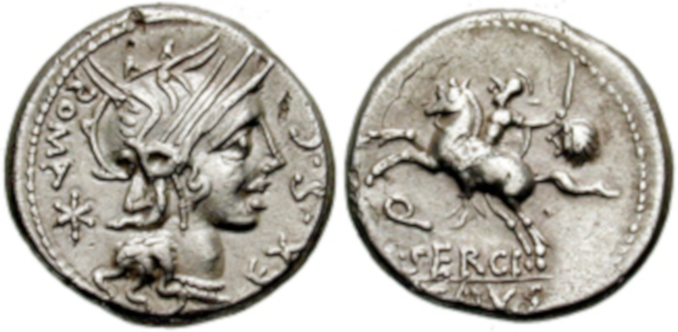
The Italian peninsula is also the land of origin of two very enduring currencies: the florin and the ducat. The Florentine gold florin kept being struck from 1252 to 1533 without major design changes. One side features the symbol of Florence—a fleur-de-lys—while the obverse has an image of John the Baptist, who is raising his hand in benediction and holding a cross-tipped scepter.
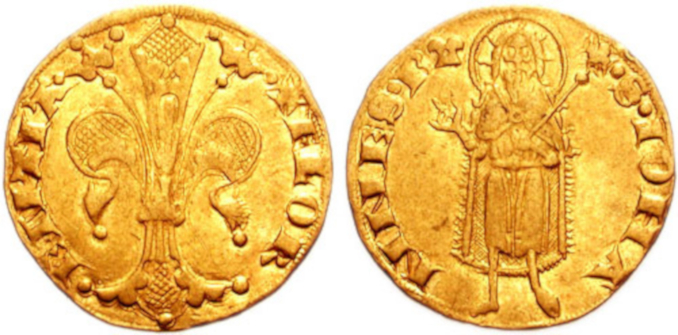
Artistically, this is not the most interesting design, but it speaks of the enduring power of this currency, which during the Renaissance was minted by 150 different states and mints. This particular coin above comes from a hoard discovered in 1985 in the small Polish town of Środa. In the 14th century, a Jewish banker lent money to the Czech king Karel IV, and this hoard was a security against the loan. The treasure of gold florins, a bejeweled wedding crown, and some rings were buried hastily when the banker was fleeing an oncoming plague. He was never able to return and retrieve the treasure.
The Italian word “florin” began to denominate any gold coin. In northern countries, a similar trend took the form of the “gulden” or guilder, the Dutch gold coin that served as currency in the Netherlands and its colonies from the 17th century until the introduction of the euro in 2002. Guilders eventually became smaller denomination coins, while the most valuable Dutch gold coin was a ducat.
When the Dutch colonial governor Peter Minuit purchased, in 1626, the island of Manhattan from the native tribes living there, he paid them in trinkets worth about 24 dollars (the equivalent of about $1000 in today’s money). A member of the Dutch West India Company, Pieter Schagen, reported this great deal to his superiors: “The island of Manhattes (was purchased) from the Indians for the value of 60 guilders. ” Minuit did not fare very well as a governor, dismissed a few years later for some unspecified transgressions. He then worked for the Swedes, trying to set up a colony of New Sweden, but his efforts came to a halt when he drowned in a hurricane near St. Kitts.
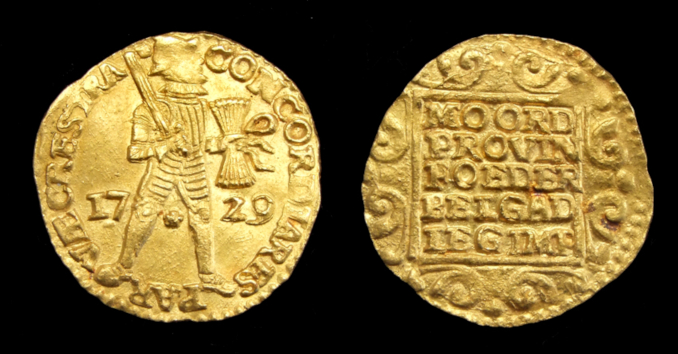
“The Flying Deer.” Photo: Wikimedia Commons
Speaking of shipwrecks, the gold ducat coin above comes from a famous shipwreck. In 1735, the Dutch merchant ship ‘t Vliegend Hert (“the Flying Deer”) departed the Netherlands for the colony of Batavia (present-day Jakarta), but it only made it as far as the territorial waters of the current Belgium. When it sank during a storm, it went down with a cargo of gin, iron, gunpowder, and a coffer of 2000 gold ducats and 5000 silver reales. There may have been much more on board, but this is what was recovered in 1985. The gold ducat from this sunken treasure is a Dutch version of the Venetian ducat. When the Dutch Republic started minting them, they adapted a Venetian’s ducat design of St. Mark into an image of a knight who holds seven arrows representing seven united provinces of the republic, surrounded by the motto Concordia Res Parvae Crescunt (“by concord small things increase”).
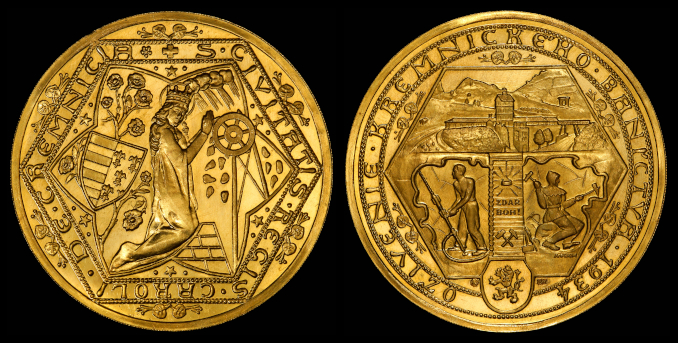
The ducat became one of the most stable and widespread currencies of Europe. From the 15th century until well into the 20th, the gold ducats were struck in many parts of the continent, particularly in parts of the Austrian-Hungarian empire. The coin above is an example of a Czech gold ducat from 1934 commemorating Slovakian gold mines in the Kremnica Mountains. This mine and its mint entered into operation in the 9th century, and by the 14th century, they were minting these Kremnica gold ducats. The gold deposits in the mine dwindled with time, but the mine was reopened in the 1930s (and closed again in 1970), and this coin was struck to celebrate the reopening. It is very rare (only a few hundred exist), and it features an Art Deco-style design of the working miners. The obverse features St. Catherine praying and the name of the Kremnica mine.
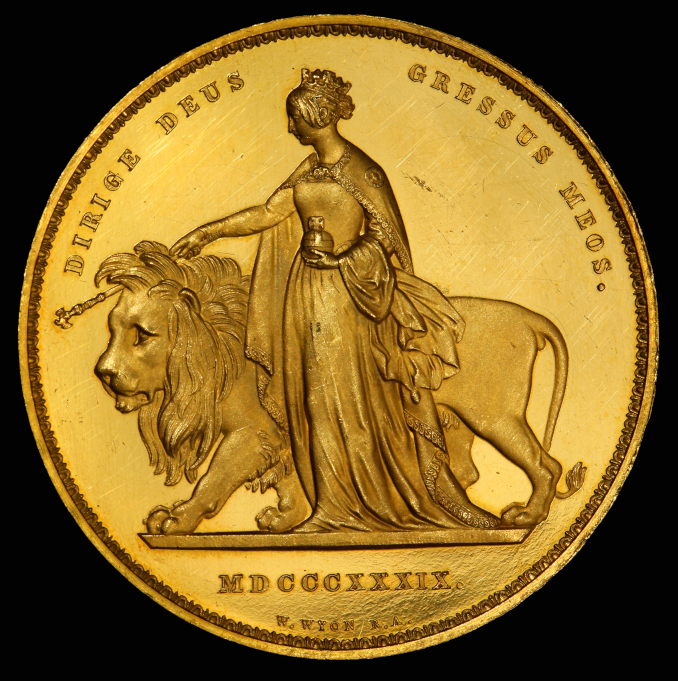
Photo: Wikimedia Commons
With the colonial might of the British empire, England had one of the most reliable currencies—the British pound—which has the honor of being the oldest continuing currency. Already in the year AD 980, you could buy 15 cows for a pound. There has clearly been some inflation since…. To commemorate the 1837 start of Queen Victoria’s reign, a chief engraver of the British Royal Mint named William Wyon designed one of the most beautiful and unique British coins—the “Una and a Lion” gold 5 pound coin. He also designed numerous medals and stamp dies (the famous Penny Black stamp is based on his engraving), as well as his very familiar design of the young Queen Victoria’s head that graced all the pennies and other coins. He began engraving her image when Victoria was 13 years old. The name “Una and the lion” refers to the queen as Lady Una, a character from Edward Spenser’s The Faerie Queen. Victorian England was very much in love with medieval and Renaissance literature, symbolism, and art style. The marriage of this poem from the 1590s with the neoclassical design resulted in this unconventional coin—unusual because royals were not typically portrayed as fictional characters. The lion that Victoria is guiding with her scepter is a symbol of England. The obverse of this coin has the traditional image of the monarch’s head, but the lion design is what makes this coin a unique and collectible work of art. A collector’s item from the start, the original 5 pound coin was auctioned in 2017 for 340,000 pounds. The Royal Mint reissued it in 2019 with the image of Queen Elizabeth II.
Coins have always been used to give witness to historic changes and to date events. Some coins can also give us a glimpse into the artistic style of the era or provide visual symbolism of past cultures.
